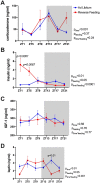Timing of Food Intake Drives the Circadian Rhythm of Blood Pressure
- PMID: 33415319
- PMCID: PMC7772288
- DOI: 10.1093/function/zqaa034
Timing of Food Intake Drives the Circadian Rhythm of Blood Pressure
Abstract
Timing of food intake has become a critical factor in determining overall cardiometabolic health. We hypothesized that timing of food intake entrains circadian rhythms of blood pressure (BP) and renal excretion in mice. Male C57BL/6J mice were fed ad libitum or reverse feeding (RF) where food was available at all times of day or only available during the 12-h lights-on period, respectively. Mice eating ad libitum had a significantly higher mean arterial pressure (MAP) during lights-off compared to lights-on (113 ± 2 mmHg vs 100 ± 2 mmHg, respectively; P < 0.0001); however, RF for 6 days inverted the diurnal rhythm of MAP (99 ± 3 vs 110 ± 3 mmHg, respectively; P < 0.0001). In contrast to MAP, diurnal rhythms of urine volume and sodium excretion remained intact after RF. Male Bmal1 knockout mice (Bmal1KO) underwent the same feeding protocol. As previously reported, Bmal1KO mice did not exhibit a diurnal MAP rhythm during ad libitum feeding (95 ± 1 mmHg vs 92 ± 3 mmHg, lights-off vs lights-on; P > 0.05); however, RF induced a diurnal rhythm of MAP (79 ± 3 mmHg vs 95 ± 2 mmHg, lights-off vs lights-on phase; P < 0.01). Transgenic PERIOD2::LUCIFERASE knock-in mice were used to assess the rhythm of the clock protein PERIOD2 in ex vivo tissue cultures. The timing of the PER2::LUC rhythm in the renal cortex and suprachiasmatic nucleus was not affected by RF; however, RF induced significant phase shifts in the liver, renal inner medulla, and adrenal gland. In conclusion, the timing of food intake controls BP rhythms in mice independent of Bmal1, urine volume, or sodium excretion.
Keywords: Bmal1; blood pressure; circadian rhythms; sodium excretion; time-restricted feeding.
© The Author(s) 2020. Published by Oxford University Press on behalf of American Physiological Society.
Figures












References
-
- de la Sierra A, Gorostidi M, Banegas JR, Segura J, de la Cruz JJ, Ruilope LM.. Nocturnal hypertension or nondipping: which is better associated with the cardiovascular risk profile? Am J Hypertens 2014;27(5):680–687. - PubMed
-
- Fukuda M, Uzu T, Kimura G.. Duration until nighttime blood pressure fall indicates excess sodium retention. Chronobiol Int 2012;29(10):1412–1417. - PubMed
-
- Bankir L, Bochud M, Maillard M, Bovet P, Gabriel A, Burnier M.. Nighttime blood pressure and nocturnal dipping are associated with daytime urinary sodium excretion in African subjects. Hypertension 2008;51(4):891–898. - PubMed
Publication types
MeSH terms
Substances
Grants and funding
LinkOut - more resources
Full Text Sources
Research Materials
